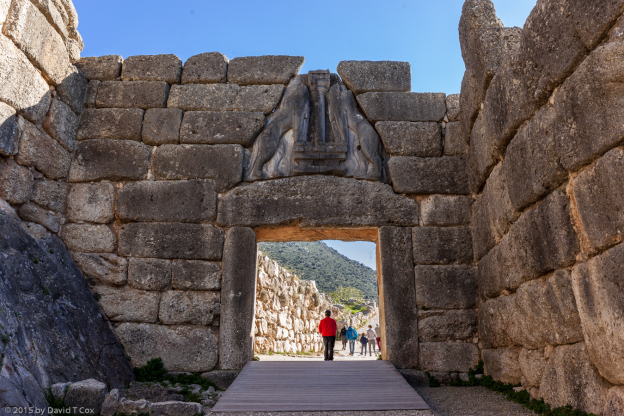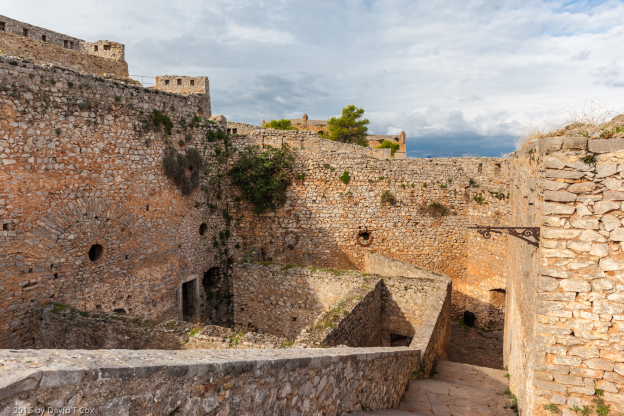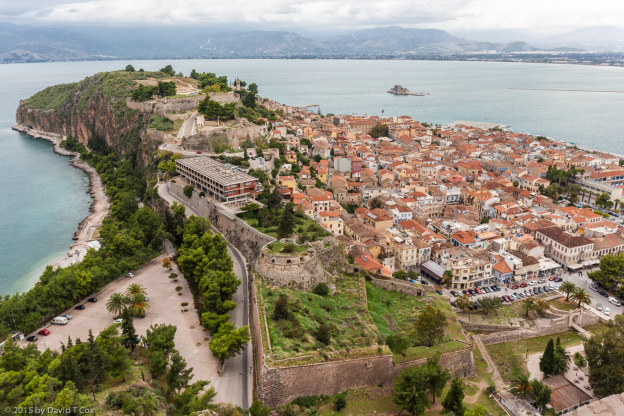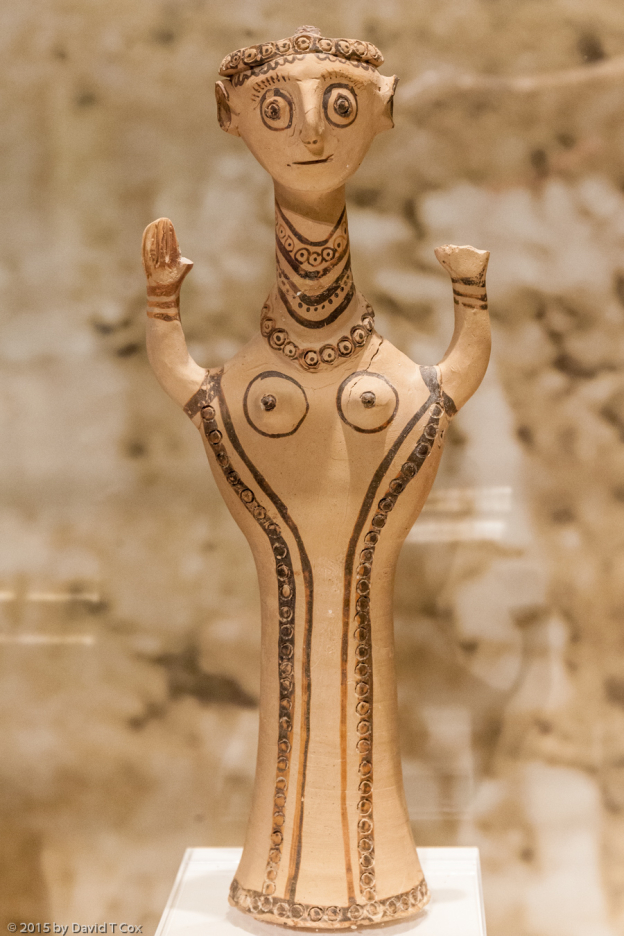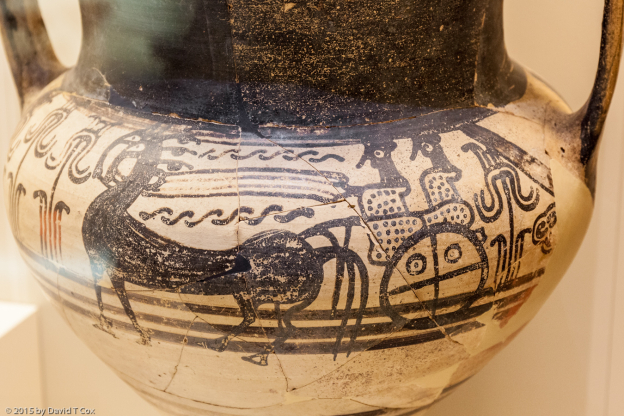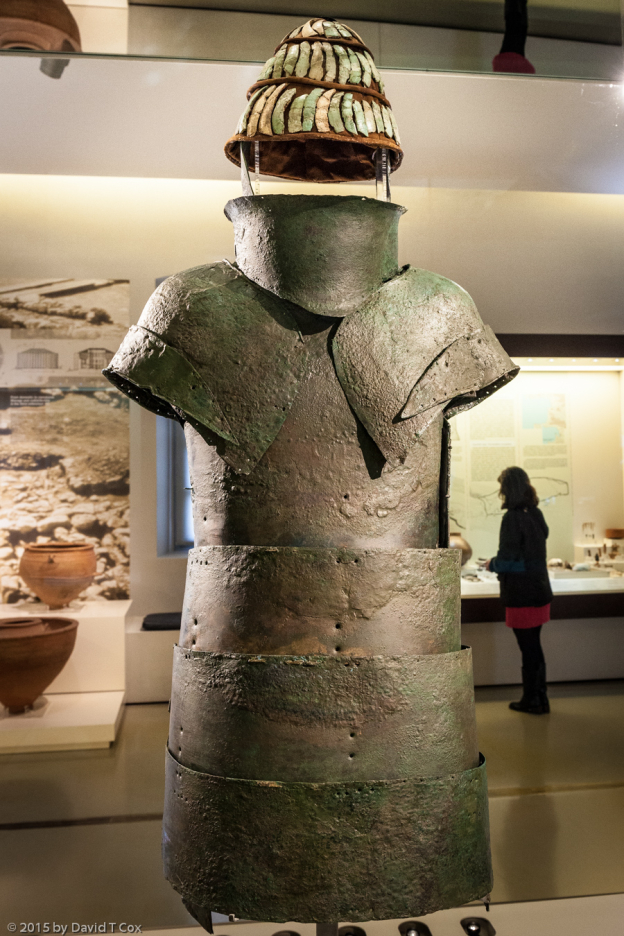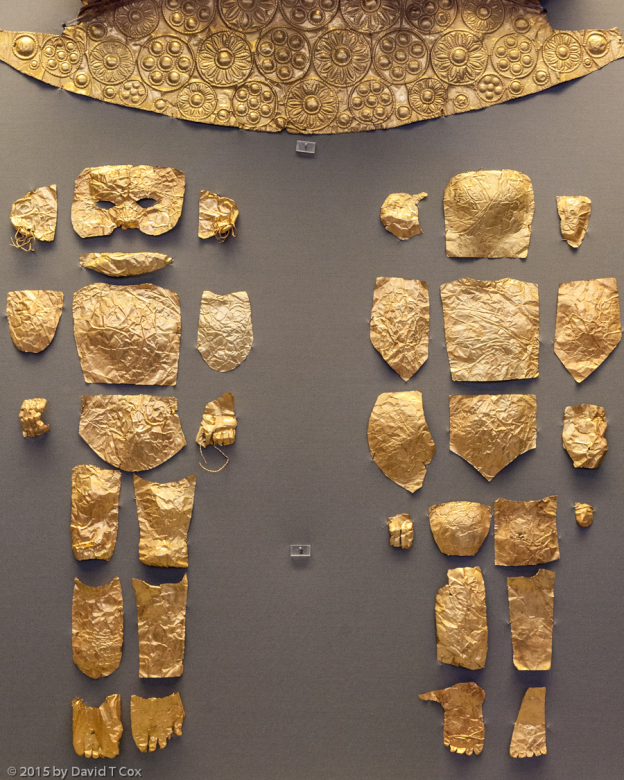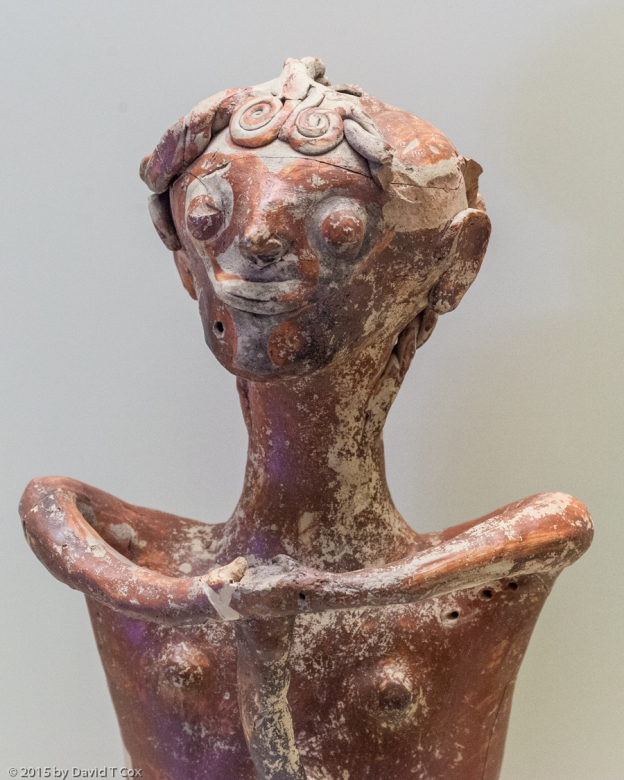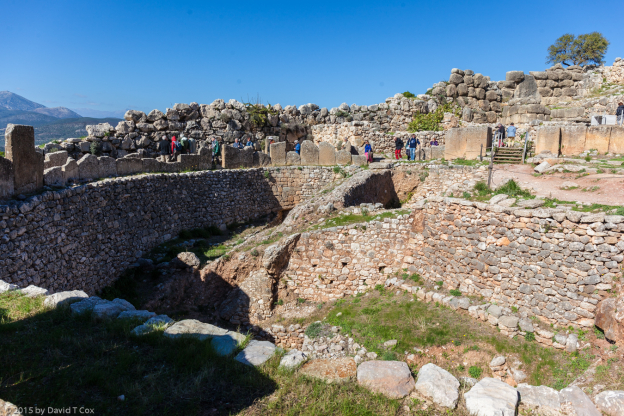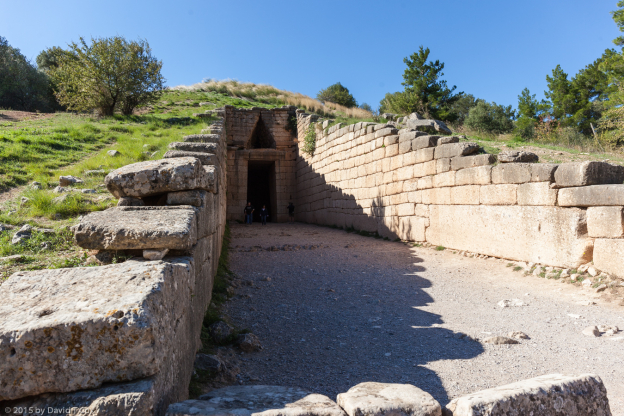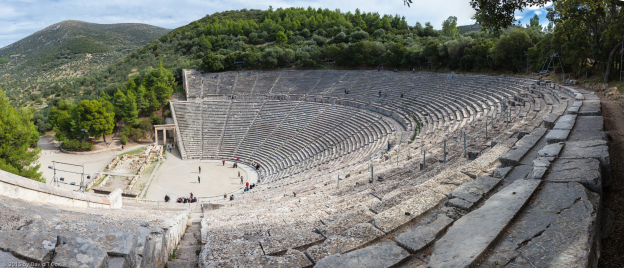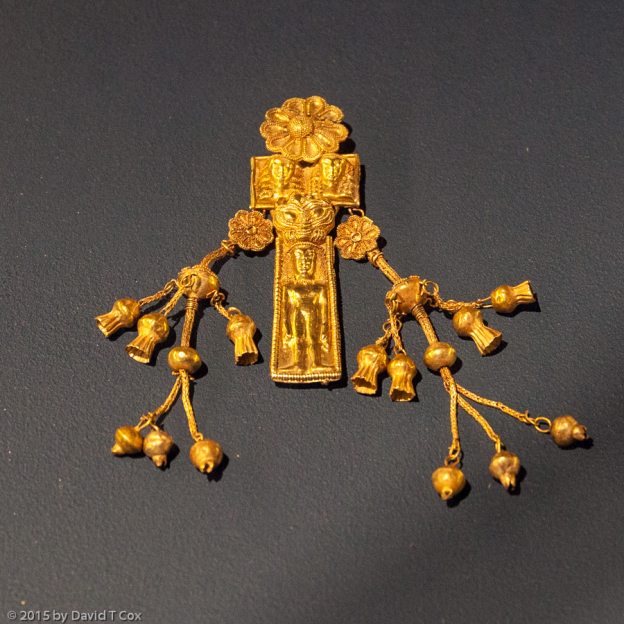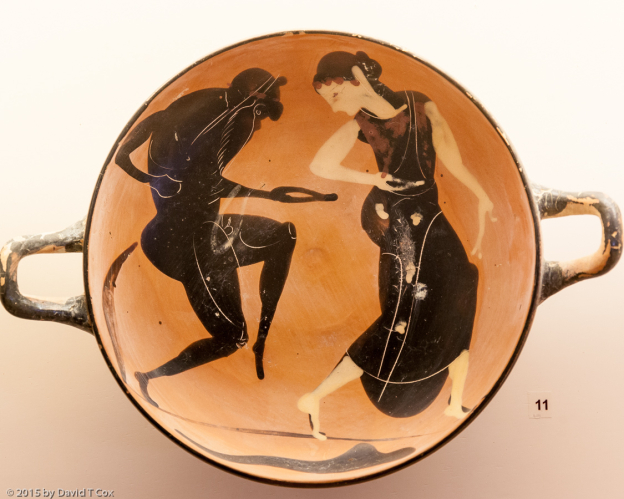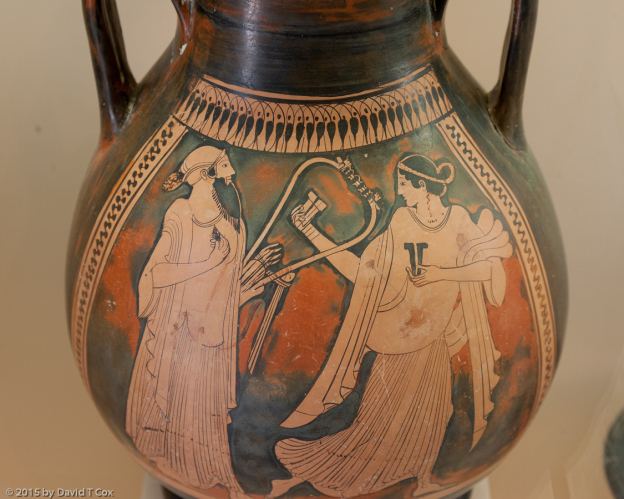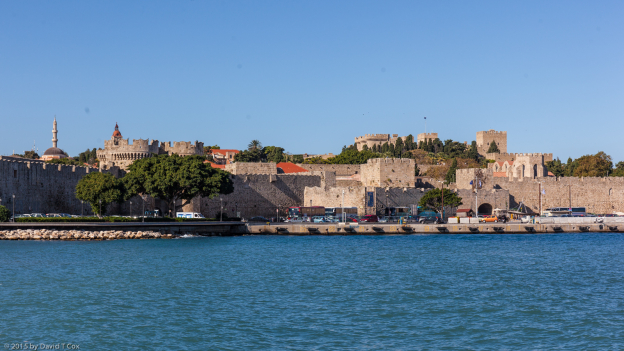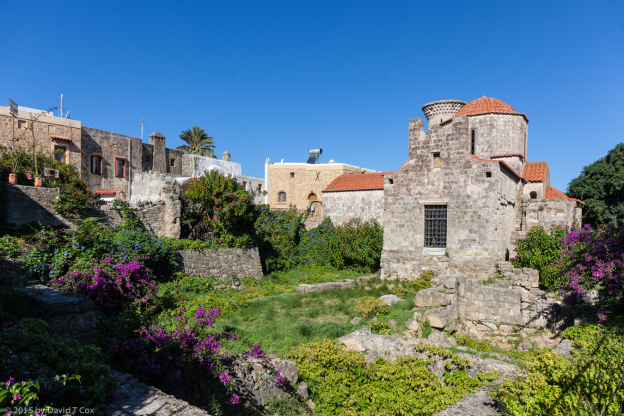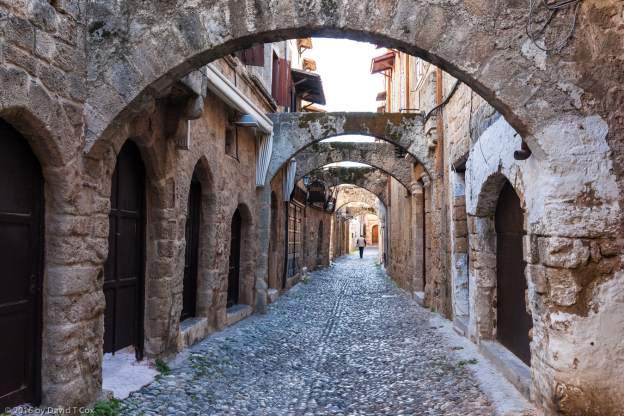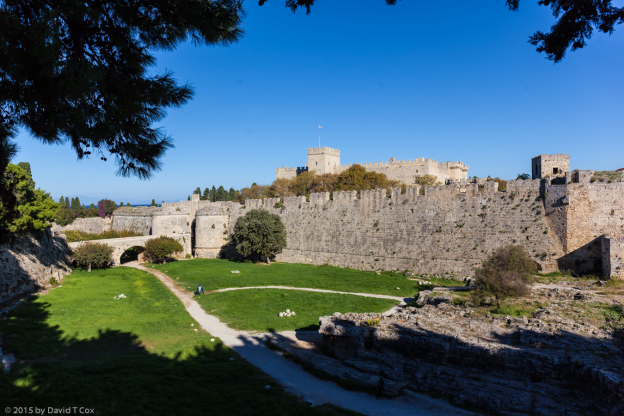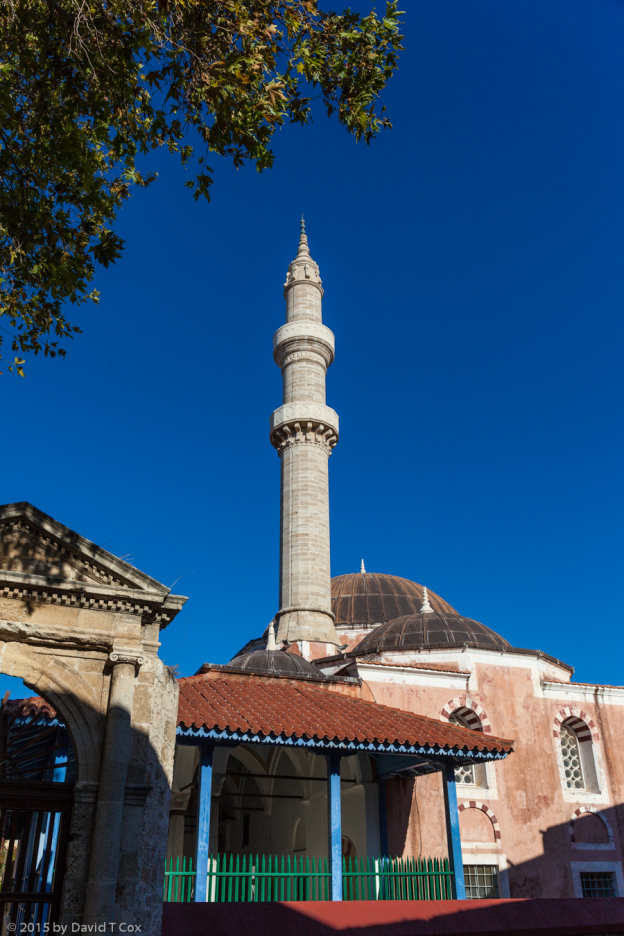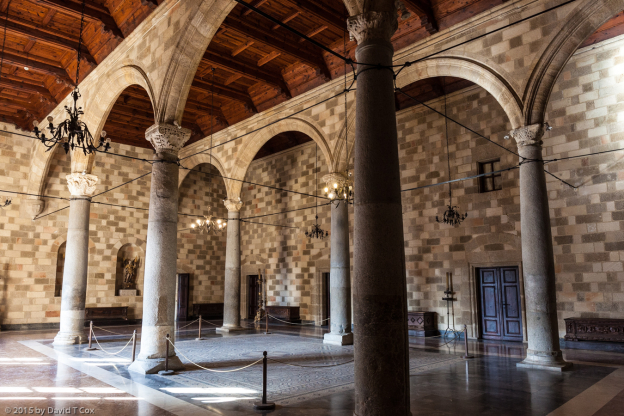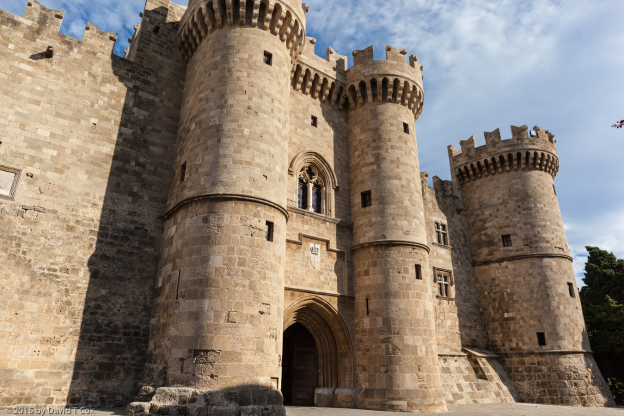All Photos Are Below the Travelogue Text
Click on Any Photo To Open Slide Show
To print the travelogue, right click anywhere on the page. Choose "Print" from your browser dialog box. You can choose Save to PDF in the browser print window.
Share your thoughts.
Email Dave - coxdavid55@hotmail.com
Hello. I last reported from Monamvasia. From there I traveled by bus to Nafplio on the SE Peloponnese, where I spent 7 days visiting nearby ancient sites. Nafplio is a delightful small town; the “old town” an ancient port city. Today’s narrow passageways and streets mostly date from Venetian periods (15th-18th centuries) and it became the first capital of Greece for a decade or so, right after independence in 1829, until the capital was moved to Athens. Nafplio is surrounded by not one, but 3 different fortresses; the most imposing is the Venetian fortress known as the Palamidi, which encircles the top of the 720 foot mountain top overlooking Nafplio from the east. The ancient staircase switches back and forth as it climbs straight up the cliff face to the battlements. The Fortress has 7 different bastions, or castles, within its walls, all built in the early 1700s. I had a small hotel room at the top of an old building in the old town, with a small balcony overlooking the red-tiled roofs of much of the town spilling out to the sea, and a full view of the western face and staircase of Palamidi Fortress. I watched from the balcony each evening, drinking wine, as the bastions, great staircase and cliff sides turned completely gold in the setting sunlight, and visitors like ants marched down the 999 steps from the Fortress.
Nafplio lies just a few miles from the two major Palace-Fortresses of the very ancient Mycenaean Kingdom, Mycenae and Tiryns. I pointed out in a previous report that Greece enjoyed two great eras of flowering of ancient civilizations, separated by several hundred years of the Greek “Dark Age.” The flowering which followed the Dark Age was the Archaic-Classical-Hellenistic era which generally is considered “The” Greek culture, and forebearer of Western Civilization. The earlier flowering era, prior to the Greek Dark Age, was during the middle and late bronze age, and is divided into 3 separate groupings by geography, though all interacted. The islands produced the earliest civilizations, on Crete the Minoan civilization and on the smaller island group known today as the Cyclades, the Cycladic civilization. Both persisted through the 2nd millennium BC, although the Minoan civilization was subsumed into the third group, which flowered on the Peloponnese mainland from about 1500-1100 BC – this latter was the great Mycenaean Kingdom, famed by Homer for engaging the Trojan War. The palace and tombs of Mycenae are real, as discovered along with Troy by Schlieman, in the 19th century, and produced as stunning a collection of treasure as ever found. Most of those artifacts are in the Athens Museum of Archaeology, and I previously have uploaded photos of some of my favorite pieces.
Last week I traveled by bus to visit the hilltop Palace Fortress of Mycenae. One enters through the famous “Lion Gate,” built as a megalithic stone lintel; all fortress walls are built of giant stones, each cut individually to fit without mortar over those below. The ancient Greeks that came after the Dark Age were amazed at the size of the rocks, and concluded the fortresses only could have been built by the giant cyclops, so the Mycenaean fortress construction is referred to as “cyclopean”. Just inside the Lion Gate is one of the several amazing circular tombs – Tomb Circle A excavated by Schlieman; giant royal interments used over centuries, from the Tomb Circles multiple royal graves came the many treasures in the museums. A couple of days later I visited the nearby ancient Mycenaean port Palace-Fortress of Tiryns. Today, due to silt, it lies several kilometers from the sea, but served as the port and major trading city of the Mycenaeans. It also is constructed of cyclopean walls. Mycenae and Tiryns together comprise a World Heritage Site.
I spent one day traveling by bus to the Archaic-Classic-Hellenistic Period ruins of the Sanctuary of Asclepius and ancient Theater of Epidaurus, another World Heritage Site. The Sanctuary of Asclepius was dedicated to the healing arts, Asclepius being the God of healing, and made much use in ancient times of serpents, although it is not clear exactly how they figured in the practice. The rod of Asclepius, with entwined serpent, has become the worldwide symbol of the medical profession. The Theater, dating from the 5th century BC, is considered by many to be in the finest condition of any Classical period theater, and is in use today for the summer presentation of plays.
From Nafplio I traveled back to Athens last Thursday, and the next day flew to the Island of Rhodes. Rhodes Town, the capital on the northern tip, sits less than 12 miles from the coast of Turkey, and I was surprised to find it is just 50 miles from Fethiye and Oludeniz from where I sailed on a Turkish Gulet 10 years ago. Rhodes had major seafaring settlements through the Greek Dark Ages, Archaic and Classical Periods. Indeed, the Rhodes Town harbor was the location of the Colossus of Rhodes, a titanic bronze statue of Apollo erected in 305 BC, and one of the 7 Ancient Wonders of the World. Rhodes of Classical Greece held a population of 100,000, much larger than it is today. What is known as the “Old Town”, completely enclosed within massive 40 foot double walls, and 30 meter wide moats, is almost entirely medieval, with just a few patches of Classic Period ancient walls excavated here and there. The Old Town, another World Heritage Site, was mostly constructed and maintained for over 200 years (1309-1522) by the Order of the Knights of St John, better known as the Knights Hospitaller, for centuries the last bastion of parts of Greece against the Ottoman Turks. The Knights were differentiated into seven different language groups of medieval western Europe, including Castillano, Italian and French, and were housed in seven different “Inns” or quarters, all built along a long sloping street now named the Street of the Knights. Each “tongue” (group by language) was responsible for the protection of a different Gate and segment of outer walls and bastions of Old Town. At the top end of the Street of Knights is the Palace of the Grand Masters, the headquarters and residence of head of the Knights Hospitaller Order. At the lower end, now converted to the local archaeology museum, is the great structure of the Knights Hospital. Rhodes finally fell to Suleyman the Magnificent of the Ottoman Empire, more than 70 years after the fall of Constantinople; according to records Suleyman arrived on the island with 400 ships carrying between 100,000 and 200,000 troops, and still took a 6 month siege to defeat the force of 7,000 Knights defending the Old City. After the defeat Suleyman permitted the remaining Knights to return to Malta. For 400 years Rhodes Old Town declined under Ottoman rule, until liberated in the very early 20th century by Italy, which promptly removed almost all traces of Muslim construction, restoring the Old Town to the medieval gem that it is today.
Two days ago I traveled by bus down the eastern coast of Rhodes to the tiny white-washed village of Lindos, sitting at the sea edge under the mountaintop Acropolis Lindos, where the Venetian Fortress surrounds ancient temples dating from the Greek Dark Age through the Archaic and Classical Periods. The town of Lindos, although practically empty when I was there, has such narrow cobblestone passageways that all traffic, including motorbikes, is banned. Tour buses, when they come, must stop at the highway hundreds of meters up a steep road, and only foot-traffic is allowed down and into the town. Unfortunately, at least to me, the town itself seems alive today solely for catering to tourists (which apparently simply fill the streets in the summer season). When empty, it is quite a sterile, but very clean, set of white curio shops and crepe restaurants waiting for the throngs. As the climb up to the Acropolis is steep and long, the town’s foot-traffic includes donkeys which are happily provided (for a fee) if one wishes a lift up the mountainside.
Today I fly to Heraklion, capital of Crete, finally ready to explore the oldest of the great Greek civilizations, the Minoan. Later. Dave
- Bastion of Miltiades, Venetian, 1711-1714, Palamidi Fortress, Nafplio, Greece
- view over Nafplio from Bastion of Aghios Andreas, Palamidi Fortress, Nafplio, Greece
- view over Nafplio from stairway to Palamidi Fortress, Nafplio, Greece
- terracotta female figure, Mycenaean, Tiryns,12th C BC, Nafplio Archaeology Museum, Greece
- ceramic krater with chariot scene, Mycenaean, Nafplio, Evangelistria chamber tomb,1350-1250 BC, Nafplio Archaeology Museum, Greece
- bronze armor & boar’s tusk helmet, Mycenaean cemetery of Dendra “The Cuirass Tomb” 12, end 15th C BC, Nafplio Archaeology Museum, Greece
- gold ornaments from Grave III (Grave of the Women), Grave Circle A, Mycenae, 16th C BC, Greece Nat. Archeological Museum , Athens, Greece
- Anthropomorphic figure, Mycenaean, 1250-1180 BC, Rm 19 of The Temple,, 13th C BC, Mycenae, Mycenae Site Archaeological Museum, Greece
- ceramic pot, Archaic to Classical Period, 7th-6th C BC, Mycenae, Mycenae Site Archaeological Museum, Greece
- Lions Gate, Mycenae, Mycenae, Greece
- Grave Circle A, Mycenae, Mycenae, Greece
- Treasury of Atreus (Tomb of Agamemnon), 14th C BC, Mycenae, Mycenae, Greece
- Theater at Epidaurus, 330-320 BC, Greece
- Knight’s Hospital, 1440 by Order of Knights of St John, now Archaeological Museum, Old Town, Rhodes, Greece
- ceramic Attic black figure amphora of Painter of Louvre, Amazon flanked by sphinxes, from cremation burial, Marmao, 560-550 BC, Rhodes Archaeological Museum, Old Town, Rhodes, Greece
- Rhodian gold silver alloy pendants, funerary artifacts from “tomb w jewels”, Kamiros, 650-600 BC, Rhodes Archaeological Museum, Old Town, Rhodes, Greece
- black-figure cup depicting satyr & maenad dancing, burial, Macri Langoni, ca 500 BC, Rhodes Archaeological Museum, Old Town, Rhodes, Greece
- Attic red-figure pelike depicting man with lyre woman w Clappers, by the Pig Painter, burial of infant, Macri Langoni, 475-450 C BC, Rhodes Archaeological Museum, Old Town, Rhodes, Greece
- Old Town from Tourist Harbor, Rhodes, Greece
- St Johns Gate (Red Gate) Pano, Old Town, Rhodes, Greece
- Holy Trinity Church, 15th C, Old Town, Rhodes, Greece
- passageway, Old Town, Rhodes, Greece
- western walls, Old Town, Rhodes, Greece
- Suleyman Mosque, Old Town, Rhodes, Greece
- Palace of the Grand Masters, Order of Knights of St John, Old Town, Rhodes, Greece
- Palace of the Grand Masters, Order of Knights of St John, Old Town, Rhodes, Greece
To print the travelogue, right click anywhere on the page. Choose "Print" from your browser dialog box. You can choose Save to PDF in the browser print window.
Share your thoughts.
Email Dave - coxdavid55@hotmail.com
